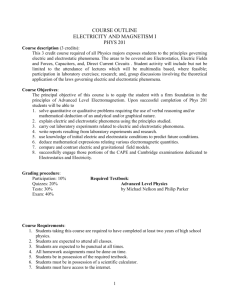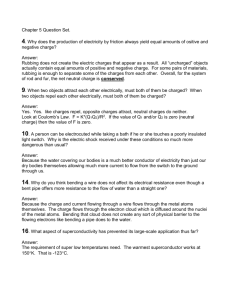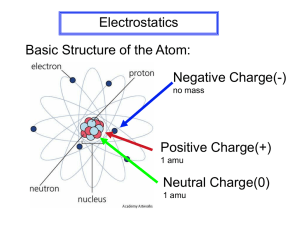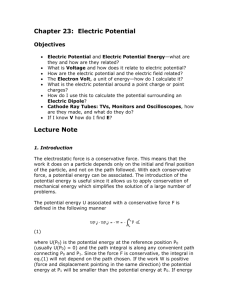Electrostatic charge notes
advertisement
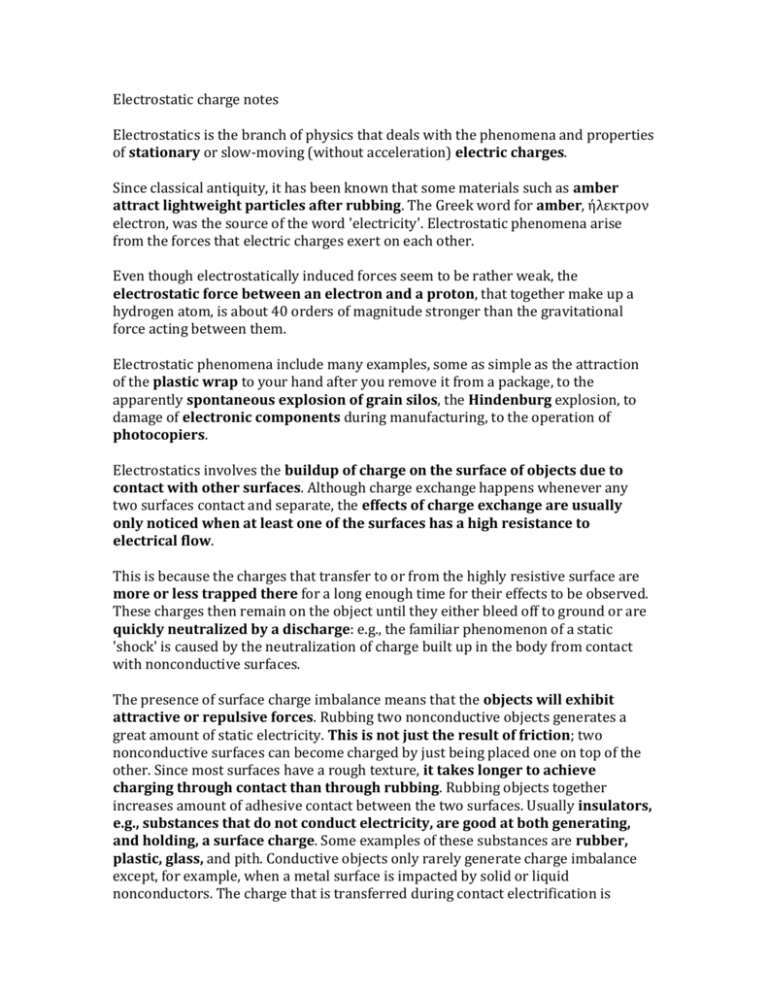
Electrostatic charge notes Electrostatics is the branch of physics that deals with the phenomena and properties of stationary or slow-moving (without acceleration) electric charges. Since classical antiquity, it has been known that some materials such as amber attract lightweight particles after rubbing. The Greek word for amber, ήλεκτρον electron, was the source of the word 'electricity'. Electrostatic phenomena arise from the forces that electric charges exert on each other. Even though electrostatically induced forces seem to be rather weak, the electrostatic force between an electron and a proton, that together make up a hydrogen atom, is about 40 orders of magnitude stronger than the gravitational force acting between them. Electrostatic phenomena include many examples, some as simple as the attraction of the plastic wrap to your hand after you remove it from a package, to the apparently spontaneous explosion of grain silos, the Hindenburg explosion, to damage of electronic components during manufacturing, to the operation of photocopiers. Electrostatics involves the buildup of charge on the surface of objects due to contact with other surfaces. Although charge exchange happens whenever any two surfaces contact and separate, the effects of charge exchange are usually only noticed when at least one of the surfaces has a high resistance to electrical flow. This is because the charges that transfer to or from the highly resistive surface are more or less trapped there for a long enough time for their effects to be observed. These charges then remain on the object until they either bleed off to ground or are quickly neutralized by a discharge: e.g., the familiar phenomenon of a static 'shock' is caused by the neutralization of charge built up in the body from contact with nonconductive surfaces. The presence of surface charge imbalance means that the objects will exhibit attractive or repulsive forces. Rubbing two nonconductive objects generates a great amount of static electricity. This is not just the result of friction; two nonconductive surfaces can become charged by just being placed one on top of the other. Since most surfaces have a rough texture, it takes longer to achieve charging through contact than through rubbing. Rubbing objects together increases amount of adhesive contact between the two surfaces. Usually insulators, e.g., substances that do not conduct electricity, are good at both generating, and holding, a surface charge. Some examples of these substances are rubber, plastic, glass, and pith. Conductive objects only rarely generate charge imbalance except, for example, when a metal surface is impacted by solid or liquid nonconductors. The charge that is transferred during contact electrification is stored on the surface of each object. Static electric generators, devices which produce very high voltage at very low current and used for classroom physics demonstrations, rely on this effect. Note that the presence of electric current does not detract from the electrostatic forces nor from the sparking, from the corona discharge, or other phenomena. Both phenomena can exist simultaneously in the same system. Static electricity is usually caused when certain materials are rubbed against each other, like wool on plastic or the soles of shoes on carpet. The process causes electrons to be pulled from the surface of one material and relocated on the surface of the other material. A static shock occurs when the surface of the second material, negatively charged with electrons, touches a positively-charged conductor, or vice-versa. Static electricity is commonly used in xerography, air filters, and some automotive paints. Static electricity is a build up of electric charges on two objects that have become separated from each other. Small electrical components can easily be damaged by static electricity. Component manufacturers use a number of antistatic devices to avoid this.


